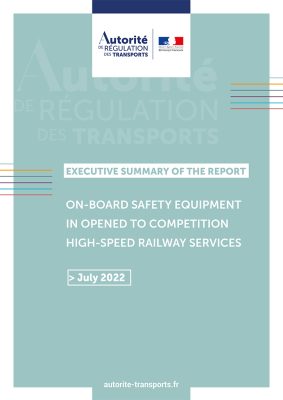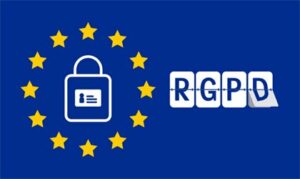
Paris, July 12, 2022 – The entry of new players into the commercial services market is a major lever for the development and dynamization of passenger rail transport and, consequently, for the decarbonization of the transport sector. However, this entry is currently hampered by the lack of network interoperability and the resulting difficulties, particularly for new operators wishing to operate high-speed services, in designing safety architectures on board their trains that are adapted to the French rail system and in ensuring their implementation under the right conditions, with a view to obtaining the authorizations required to operate on the network. In this context, the ART publishes a study on « On-board safety equipment, at a time when rail transport services on high-speed lines are being opened up to competition », in which it makes 18 concrete recommendations to remove the barriers to entry for access to on-board safety equipment.
REMOVING BARRIERS TO MARKET ENTRY IS A MAJOR LEVER FOR INCREASING THE MODAL SHARE OF RAIL IN PASSENGER TRANSPORT IN FRANCE AND THUS CONTRIBUTING TO THE DECARBONIZATION OF THE TRANSPORT SECTOR
With a modal share that has « plateaued » at 10% for several years and an average train load in France that is the highest in Europe, the French market for passenger rail transport services has significant development potential, the mobilization of which would contribute to the decarbonization of passenger transport.
However, as a recent study by the ART points out, European experience shows that opening up to competition is a major lever for the development and revitalization of passenger rail transport, in that it does not simply mean replacing services previously operated by the incumbent rail operator with similar services operated by new entrants, but is, on the contrary, the vector for a new lease of life for the rail system as a whole.
While opening up to competition is potentially a powerful lever for improving the rail system, it will only be able to deliver on all its promises if the conditions for a fair competitive playing field are properly established, which means identifying and removing the barriers to entry for new operators, particularly technical ones. This objective is at the heart of the ART’s efforts to support the opening of rail transport to competition.
DUE TO THE LACK OF INTEROPERABILITY OF THE FRENCH NETWORK, NEW ENTRANTS HAVE DIFFICULTY DESIGNING SAFETY ARCHITECTURES ON BOARD THEIR TRAINS THAT ARE ADAPTED TO HIGH-SPEED LINES, WHICH HINDERS THE DEVELOPMENT OF NEW SERVICES
The safety and operating performance of a rail network depends primarily on the signalling and control systems. These systems, which are based on a dialogue between the trains (on-board equipment) and the infrastructure (trackside equipment), make it possible to (i) control risks in the event of human error (« control-command » function) and (ii) display information and instructions directly in the driver’s cab (« signalling » function, which is essential at high speeds).
Historically, most European countries have developed and deployed specific systems, adapted to national constraints and referred to as « class B safety systems ». In order to enable the emergence of a fully interoperable European railway system, the European institutions have set a target for the deployment of a unified European rail traffic management system (ERTMS), referred to as a « class A safety system ».
Since the deployment of ERTMS requires heavy investments, the historical national systems will remain unavoidable for several decades. In particular, the deployment of ERTMS in France appears to be lagging behind the rail networks of neighboring countries and will probably be very gradual.
Under these conditions, the transitional solution provided for in the European texts to ensure network interoperability is particularly important. This is based on the provision of specific transmission modules [1] or, failing that, the adoption of mitigating measures, aimed at facilitating the movement of trains from other European operators on infrastructures equipped with historical national safety systems.
However, this transitional solution has not yet been implemented in France for traffic on high-speed lines, so several new entrants wishing to offer commercial services on the French market have informed the Authority of their difficulties in designing suitable on-board safety architectures and ensuring their implementation under the right conditions, with a view to obtaining the required authorizations.
THE STUDY PUBLISHED TODAY BY THE ART PROVIDES A PRECISE ASSESSMENT OF THESE DIFFICULTIES AND MAKES 18 RECOMMENDATIONS TO FACILITATE THE OPENING OF THE FRENCH HIGH-SPEED RAIL MARKET
The study published today by the Authority on « On-board safety equipment at a time when high-speed rail services are being opened up to competition » has a dual objective:
- On the one hand, it is intended to bring transparency and legibility to the acquisition, integration and operation of on-board safety equipment;
- On the other hand, it aims to facilitate the arrival of new entrants on the French railway market by formulating 18 concrete recommendations to the players in the sector, grouped around 5 general recommendations.
| # | General recommendation | Explanations |
| 1 | Assign responsibility for Class B safety systems in France to a « system authority » |
It appears necessary to designate an entity responsible for historical Class B safety systems in France. In the short term, it would be responsible for accompanying the entry of new operators and for monitoring the sector as a whole. In the longer term, it will have to ensure the opening up of Class B systems in France and make sure that the products available meet the interoperability challenges and the needs of new entrants. Ideally, the Public Railway Safety Institution (EPSF) could play this role. Failing that, this role could be given to the infrastructure manager, SNCF Réseau. |
| 2 | Establish a transparent framework for new players, starting with the design of safety architectures |
It seems necessary that the entity responsible for Class B safety systems take measures to ensure timely access to the documentation required for the design of on-board safety architectures to operate on the national rail network. |
| 3 | Encourage the opening of historical systems to ensure the availability of safety equipment |
In the event of persistent difficulties, proactive measures could be taken by the public authorities to transform and open the market for class B safety equipment in France, taking into account the complex issues raised by the intellectual property rights held by manufacturers. |
| 4 | Maintain access to the know-how and skills needed to implement safety equipment |
It seems necessary to ensure that new entrants have access to the skills needed to implement historical French safety equipment, which are today partly concentrated within the historical railway company, and to ensure, in the longer term, a sufficient pool of expertise, independent of the historical operator. |
| 5 | Accelerate the deployment of ERTMS on the national rail network and ensure visibility of the timetable for the players |
Good visibility of the timetable for the deployment of ERTMS and the removal of class B safety systems would enable operators to anticipate the equipment of their rolling stock, which is particularly important to enable operators of international high-speed links to plan their arrival on the French market and for the infrastructure manager to better manage its assets. |
See
- Study « On-board safety equipment in opened to competition high-speed railway services» (in French)
- Executive summary of the study (in English)
- Press release (in French)
About the French Transport Regulatory Authority, ART
Since 2010, the French railway sector has had an independent authority to accompany its gradual opening to competition: the Autorité de régulation des activités ferroviaires (Araf). The law n°2015-990 of August 6, 2015 for growth, activity and equal economic opportunity extended the regulator’s powers to road activities – coach transport and highways.
On October 15, 2015, Araf became the Autorité de régulation des activités ferroviaires et routières (Arafer), with the mission of contributing to the proper functioning of public service and competitive activities, for the benefit of rail and road transport customers.
Competent for the regulation of airport charges since October 1, 2019, Arafer became the Autorité de regulation des transports (ART) on that date. Lastly, the law Nn° 2019-1428 of December 24, 2019 on the orientation of mobility extended ART’s powers and missions to include the opening of mobility and ticketing data, as well as the regulation of infrastructure manager activities and security activities carried out by RATP in the Île-de-France Région.
Its opinions and decisions are adopted by a college of five [2] independent members chosen for their economic, legal or technical skills in the field of digital services or transport, or for their expertise in competition matters. It has been chaired since August 2016 by Bernard Roman.
[1] A specific transmission module (STM) is a version of an on-board Class B safety system (SSCB) that allows standardised interfacing with ERTMS and thus allows ERTMS-equipped rolling stock to run on an infrastructure equipped with a Class B system.
[2] Law No. 2019-1428 of 24 December 2019 on the orientation of mobilities established a transformation of the governance of the ART’s college, which will gradually become five permanent members (the two current temporary members will end their mandate and will not be replaced).
